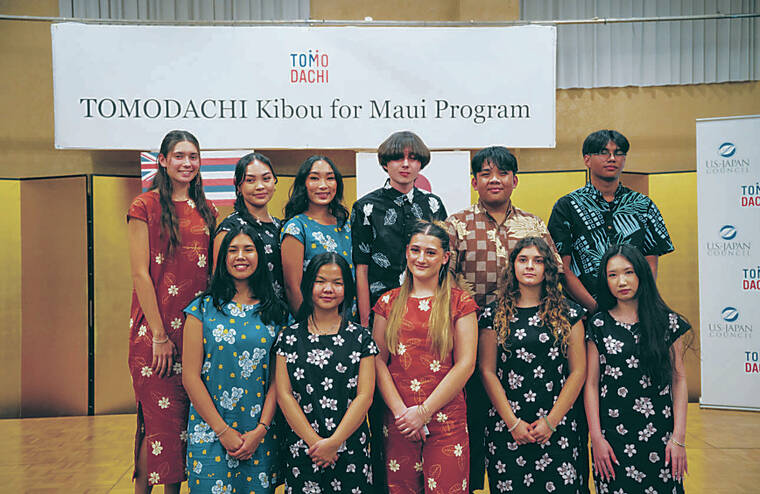After returning from their weeklong stay in Higashimatsushima, Japan, in late March, the 11 Maui students who participated in the TOMODACHI Kibou for Maui program, their families and program organizers reunited for a final gathering April 28 at the Sheraton Maui Coral Reef Room.
There the students, all of whom were affected by the Maui wildfires, reflected on their experience, while those from Japan met the students’ families and saw the town.
“I was really happy to see them again in Lahaina, and I was especially glad I was there because we’re going to have a second cohort,” said Miku Narisawa, co-director and founder of the organization that put together the students’ itinerary, Odyssey Nature Japan. “From what I saw in Lahaina … my perspective has also changed.”
TOMODACHI Kibou for Maui, a program created in partnership with the Japanese Cultural Center of Hawaii, the TOMODACHI Initiative and Odyssey Nature Japan, sent a group of high school students to the Tohoku region’s town of Higashimatsushima. The program provided the high schoolers with the opportunity to network with those who are active in the recovery from the 2011 tsunami.
Narisawa, whose hometown is in Higashimatsushima, was in middle school when the 2011 tsunami struck the Tohoku region, taking loved ones and homes from her. Following the disaster, she had the opportunity to participate in a program called Rainbow for Japan Kids, which brought her and other young survivors from the area on a trip to Hawaii to give them an outlet for their grief.
The experience affected Narisawa deeply, inspiring her to found Odyssey Nature Japan. Now the organization helps Japanese and international youths gain self-confidence while teaching them about various types of farming and agriculture, she said.
Upon hearing about the idea to create TOMODACHI Kibou for Maui, Narisawa immediately knew that she wanted to help.
“I just wanted to give something back to them, because I knew that those educational programs will eventually be part of their life somehow,” Narisawa said. “I wanted to show that there will be adults who are supporting them and who are there for the kids.”
In Japan the Maui students met tsunami survivors in forestry and aquaculture who, following the tsunami, rebuilt their businesses from the ground up. They also connected with survivors of the Fukushima nuclear disaster and visited nearby cities that had redesigned the layout of their infrastructure to better prepare for future natural disasters, said JCCH President and Executive Director Nate Gyotoku.
“They were just really inquisitive and asking them about the personal experiences that those people went through,” said Gyotoku. “With all the different layers of learning, I could see many of these Lahaina kids starting to change and see that there is hope.”
Cecelia Steiner, a Lahainauna High School senior, described a small town called Onagawa that was rebuilt after the tsunami in sections. Sections farthest from the ocean now hold schools and hospitals, ensuring that the town’s most vulnerable populations wouldn’t have trouble getting to higher ground in the event of another tsunami.
“Most of the people that died were younger kids and the elderly, and that was similar to what happened in Lahaina,” Steiner said. “They made me have a new perspective that we can rebuild in a better way so the next time this happens, it’s not so destructive.”
Efficient coordination between communities affected by the tsunami and the government also played a big role in the recovery process, Steiner added. The communities in Tohoku also held a shared value to care for the land and oceans, and rebuilt with sustainable practices in mind.
Lahainaluna junior Taika Swearingen remarked on the perseverance shown by many of the people he met on the trip. Those whose shops or farms were destroyed not only recovered, but did so with inspiring success, he said.
After seeing and speaking to the survivors of the 2011 tsunami firsthand, Swearingen said that he hopes to perpetuate their stories alongside his own. While uncertain about what he’d like to do after high school, Swearingen added that he hopes to one day find a way to pass on the joy and kindness that those behind the program have given him.
“After all that JCCH and Nature Odyssey Japan and the people at TOMODACHI did to support us 11 students,” Swearingen said, “I want everyone who helped me go on the trip to know that I appreciate them immensely.”
TOMODACHI Kibou for Maui is accepting applications for a second cohort of students to take to Japan in July. To learn more or to apply, visit shorturl.at/uxAKS Opens in a new tab.
———
Linsey Dower covers ethnic and cultural affairs and is a corps member of Report for America, a national service organization that places journalists in local newsrooms to report on undercovered issues and communities.




